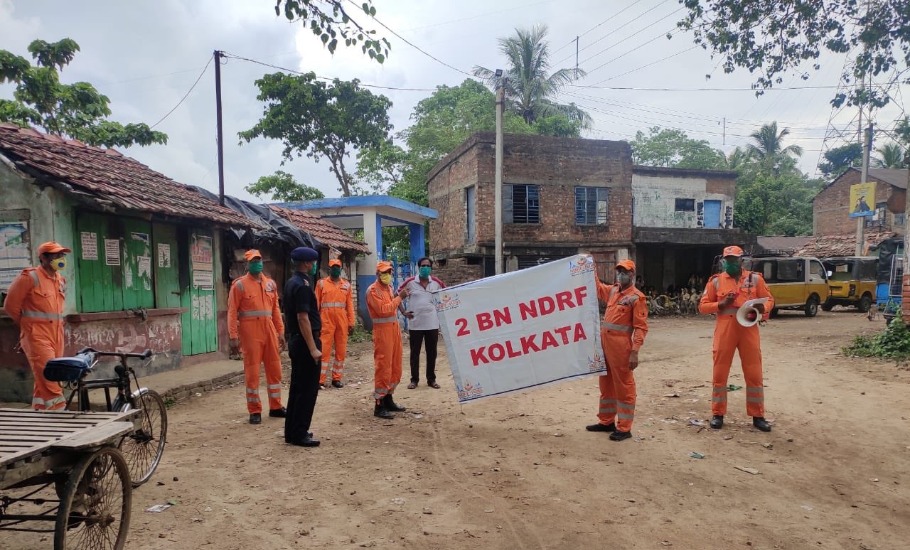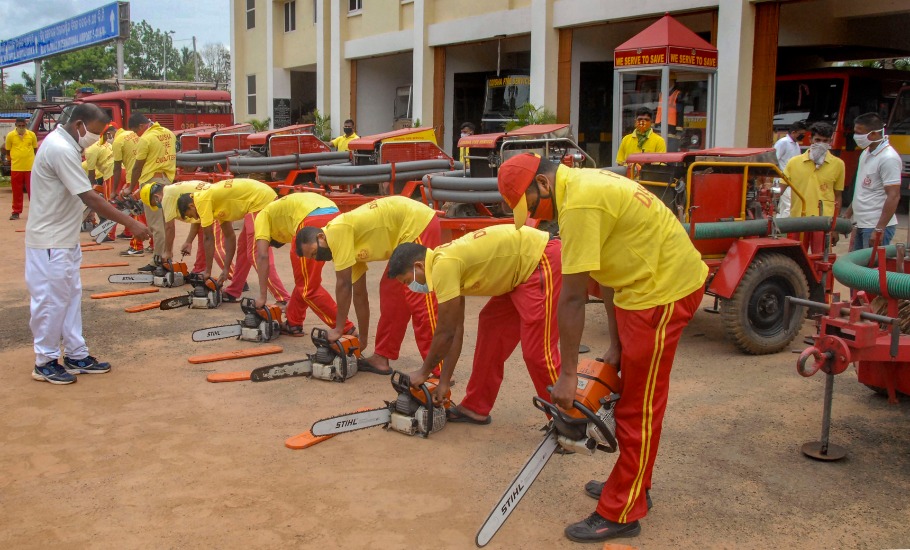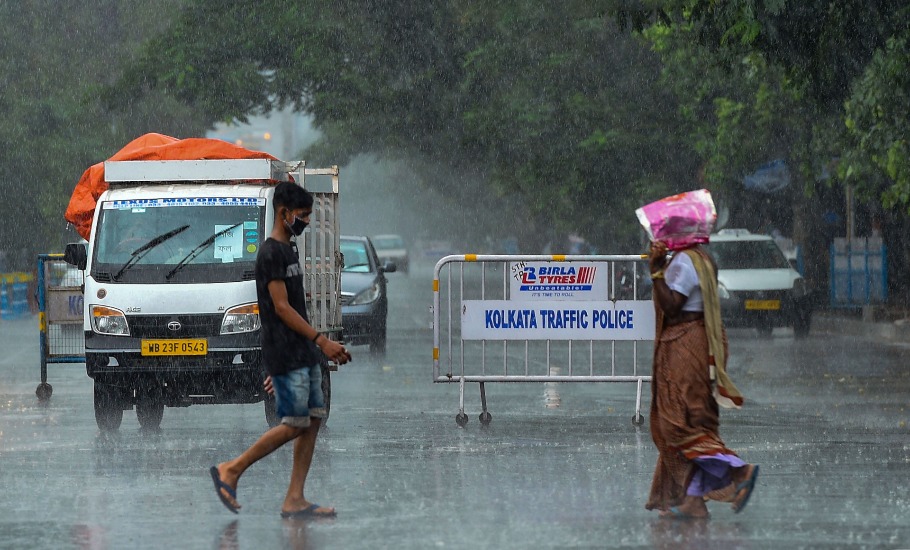
Cyclone Amphan: NDRF deploys 41 teams in West Bengal, Odisha
The National Disaster Response Force (NDRF) has deployed a total of 41 teams in West Bengal and Odisha to deal with any emergency situation arising out of cyclone Amphan, said NDRF director general SN Pradhan on Tuesday. Cyclone Amphan is the second super cyclone over the Bay of Bengal in two decades.

The National Disaster Response Force (NDRF) has deployed a total of 41 teams in West Bengal and Odisha to deal with any emergency situation arising out of cyclone Amphan, said NDRF director general SN Pradhan on Tuesday (May 19). Cyclone Amphan is the second super cyclone over the Bay of Bengal in two decades.
Pradhan told a press conference Amphan is a second disaster coming in the time of already prevailing COVID-19 and that it requires continuous monitoring. It is expected to make landfall on the West Bengal coast in the afternoon of May 20 between Digha in West Bengal and Hatia island in Bangladesh as an extremely severe cyclonic storm.
“A total of 41 NDRF teams including reserves are deployed in the two Amphan-affected states of Odisha and West Bengal,” the NDRF chief said. He said cyclone Amphan will be extremely severe cyclonic storm when it makes a landfall on May 20 and that its hit potential remains strong.
Of the 41 total teams, 19 have been deployed in seven districts of West Bengal and 15 in six districts of Odisha. Two are on standby in West Bengal while five in Odisha. “We have kept an additional backup. Six NDRF battalions have been identified – 11 in Varanasi, 9 in Patna, 1 in Guwahati, 10 in Vijayawada, 4 in Arakkonam and 5 in Pune. They have military airports and troops can be brought from here on short notice,” he said.
He said the NDRF has learnt from its experience of handling cyclone Fani and has deployed tree-pole cutters in the areas which are expected to be hit. “Wireless sets, satellite phones and other communication equipment are also with our teams. Our preparation is on par with facing a super cyclone like the one that hit the Odisha coast in 1999,” he said.
#CycloneAmphan Updates 19/5/20@NDRFHQ @ Work in Kakdwip, South 24 Parganas, WB#WithThePeople #Awareness #NDRF4U#Committed2Serve #LetsFaceAmphanTogether @NDRFHQ @ndmaindia @PMOIndia @HMOIndia @PIBHomeAffairs @BhallaAjay26 @DDNewslive @ANI @airnewsalerts @PTI_News pic.twitter.com/p8Vz3q15OA
— ѕαtчα prαdhαnसत्य नारायण प्रधान ସତ୍ଯପ୍ରଧାନ-DG NDRF (@satyaprad1) May 19, 2020
The super cyclone, meanwhile, weakened into an extremely severe cyclonic storm over the west-central Bay of Bengal on Tuesday afternoon as it rolled towards the Indian shores in West Bengal and Odisha. The two states are on high alert, as the cyclone, cramming high-velocity winds, triggered rains in several parts of Odisha.
An India Meteorological Department (IMD) bulletin said the cyclone lay centred over west-central Bay of Bengal, about 520 km south of Paradip in Odisha and 670 km south-southwest of Digha in West Bengal. It was moving north-northeastwards at a speed of 14 kmph.
Evacuation
West Bengal Chief Minister Mamata Banerjee said around three lakh people have been evacuated from the coastal areas in the state. The evacuees, she said, have been shifted to cyclone shelters. Authorities, however, were mindful of the difficulty they could face in ensuring social distancing norms at these shelters in the state which has witnessed a surge in COVID-19 cases over the last few days.
“Indeed, there will be some problems but we will ensure that social distancing is maintained at cyclone centres,” she said. Banerjee said she will talk to the railways and ask it to not run Shramik Special trains to the state to bring back migrant labourers from Wednesday till Thursday morning as a precautionary measure.
Odisha is in a state of readiness to evacuate around 11 lakh people living in vulnerable areas, officials said. The process has already started and an unspecified number of people have been sheltered in cyclone centres.

Coastal districts of North and South 24 Parganas, and East Midnapore, including the ecologically fragile Sundarbans, in West Bengal face a serious threat of inundation and significant damage to life and property.
The government, in view of the COVID-19 pandemic, has distributed more than two lakh masks among the evacuees, and Personal Protective Equipment (PPEs) have been handed out to the State Disaster Relief Force (SDRF) personnel deployed in the vulnerable areas, a senior official said.
Union Home Minister Amit Shah spoke to chief ministers of West Bengal and Odisha — Mamata Banerjee and Naveen Patnaik — and assured them of all possible help to deal with the situation, officials said in New Delhi.
Related news: Social distancing goes for a toss as 3 lakh evacuated ahead of cyclone in WB
As Amphan rumbled towards the Indian coastline, the effect was felt in Puri, Kendrapara, Jagatsinghpur and Khurda districts of Odisha which witnessed light rain and wind. Both are set to intensify over Tuesday and Wednesday.
IMD Director-General Mrutyunjay Mohapatra said since the cyclone is gradually weakening, its impact is unlikely to be very severe in Odisha. However, coastal districts like Jagatsinghpur, Kendrapara, Bhadrak and Balasore are likely to be battered by heavy rains and high-velocity winds from Tuesday evening, he said.

Fourteen teams of National Disaster Response Force, each consisting of 45 personnel, and 20 units of Odisha Disaster Rapid Action Force (ODRAF) have been deployed in the districts likely to be hit. In West Bengal, a disaster management official said around 4,000 SDRF personnel are monitoring the evacuation operation. “The entire fishermen community has been asked not to venture out to the sea for the next two days, and those who are at sea have been asked to return,” the official said.
Relief materials, including dry food and tarpaulin, have been dispatched to coastal areas, he said. Quick response teams comprising trained civil defence volunteers and vehicles with safety gear have already reached the districts. The State Emergency Operation Centre at the secretariat is in constant touch with the exigency units set up in the districts, he said.
The state’s forest department has, meanwhile, formed rapid response teams to ensure that tigers from Sundarbans in South 24 Parganas do not stray into nearby human settlements. Chief Wildlife Warden Ravi Kant Sinha said a control room has been set up at Gosaba to monitor the situation in the mangrove forests round-the-clock. Rapid response teams have been deployed in Sajnekhali and Jharkhali in South 24 Parganas with tranquiliser guns, nets and speed boats to negotiate the creeks during urgency.
(With inputs from agencies)


